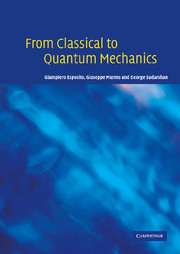Book contents
- Frontmatter
- Contents
- Preface
- Acknowledgments
- Part I From classical to wave mechanics
- 1 Experimental foundations of quantum theory
- 2 Classical dynamics
- 3 Wave equations
- 4 Wave mechanics
- 5 Applications of wave mechanics
- 6 Introduction to spin
- 7 Perturbation theory
- 8 Scattering theory
- Part II Weyl quantization and algebraic methods
- Part III Selected topics
- References
- Index
3 - Wave equations
Published online by Cambridge University Press: 14 January 2010
- Frontmatter
- Contents
- Preface
- Acknowledgments
- Part I From classical to wave mechanics
- 1 Experimental foundations of quantum theory
- 2 Classical dynamics
- 3 Wave equations
- 4 Wave mechanics
- 5 Applications of wave mechanics
- 6 Introduction to spin
- 7 Perturbation theory
- 8 Scattering theory
- Part II Weyl quantization and algebraic methods
- Part III Selected topics
- References
- Index
Summary
A physics-oriented review is first given of wave equations: examples, the Cauchy problem, solutions in various coordinates, their symmetries, how to build a wave packet. Fourier analysis and dispersion relations are then introduced, and here the key tool is the symbol of differential operators, which makes it possible to study them in terms of algebraic polynomials involving cotangent-bundle variables. Further basic material deals with geometrical optics from the wave equation, phase and group velocity (and their dual relationship in momentum space), the Helmholtz equation and the eikonal approximation for the scalar wave equation.
The Schrödinger equation is then derived with emphasis on the wave packet and its relation to classical behaviour in the light of the Einstein–de Broglie relation. For this purpose, it is shown that it is possible to build a wave packet for which the wave-like properties manifest themselves for distances of the order of atomic dimensions. The Fourier transform with respect to time of the wave packet obeys the stationary Schrödinger equation, while the wave function is found to obey a partial differential equation which is of first order in time.
The wave equation
The wave equation occurs in several branches of classical physics, e.g. the theory of sound, electromagnetic phenomena in vacuum and in material media, and elastic vibrations of material bodies. We consider first the simplest situation, i.e. the propagation of waves in a homogeneous, isotropic and stationary medium. Propagation is characterized by the refractive index n, a quantity that is independent of the point in space-time.
Information
- Type
- Chapter
- Information
- From Classical to Quantum MechanicsAn Introduction to the Formalism, Foundations and Applications, pp. 86 - 114Publisher: Cambridge University PressPrint publication year: 2004
